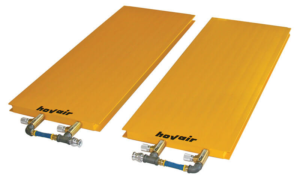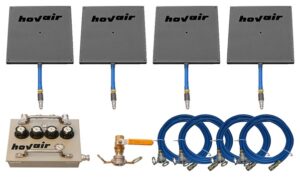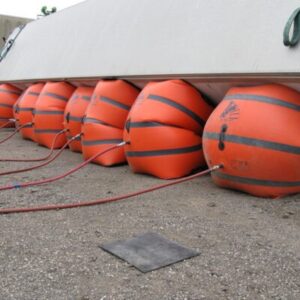Material handling is the science of receiving, packing, moving, or storing material or finished products. But manual material handling is one of the leading causes of workplace injuries in manufacturing plants, warehouses, and distribution centers across the globe.
Workers can suffer from overexertion injuries, cumulative trauma, musculoskeletal disorders, or other life-altering issues because of improper material handling practices. Paying close attention to material handling ergonomics is the smartest way to increase productivity and ensure worker safety.
What is Ergonomics in Material Handling, and Why is it Important?
The International Ergonomics Association defines ergonomics as an understanding of interactions between labor and other inanimate elements in the workplace. The principle focuses on a combination of processes, products, and systems to enhance safety for workers in any given industry. It emphasizes making tasks compatible with the abilities and limitations of workers.
Several factors, including temperature, posture, repetitive movements, bulky items, and more, impact employees’ health. Regardless of your company’s industry or size, if material handling is a task that your workers need to complete, you must provide them with worthwhile ergonomic solutions.
Or else, it could lead to increased workplace injuries, which negatively impacts employee morale and productivity, not to mention the whoppingly high turnover rates and workers’ compensation claims.
Many studies conclude that there’s a direct link between a lack of ergonomics and workplace injuries, especially musculoskeletal disorders. The current statistics are alarming and can help you get an idea regarding the magnitude of ergonomics for material handlers. Manual material handling tasks account for over 66% of all workers’ compensation filed in the United States.
The rapidly increasing demand is only likely to compound the issue. In this fast-paced world, everyone wants more products delivered faster. So, the already challenging job performed by material handlers can become even more difficult.
To grapple with the global recession, many companies are extending their workers’ hours to meet the growing demands cost-effectively. But the longer and harder material handlers will work, the higher the risk of them sustaining serious injuries.
Top Risk Factors of Non-Ergonomic Equipment in the Workplace
 Risk Factor #1- Repetitive Tasks
Risk Factor #1- Repetitive Tasks
Material handlers must be trained as to how they can perform each task more effectively without compromising safety. Your company must implement stringent practice protocols to make sure none of the workers has to perform repetitive tasks for prolonged periods.
Consider rotating employees to make them perform more than one type of task. This also helps them upgrade their skills. You’ll not have to worry if workers performing a particular task are absent, and it would add to the workplace’s ergonomics.
Risk Factor #2- Forceful Exertions
Some handlers are required to use excessive force to complete the task. Using muscles with extra force is a recipe for disaster, depending on what’s being moved. Give the workers proper weight management training and teach them counterbalancing techniques. Also, invest in ergonomic equipment such as dollies, air skids, air skates, air bearing systems, and other solutions for the automated handling of heavy loads.
Risk Factor #3- Sustaining or Repeating Awkward Poses
While they might not realize it promptly, eventually, sustained or repetitive awkward postures put tremendous force on joints, tendons, and muscles. Ergonomic equipment can eliminate the strain and allow them to avoid vulnerable positions by keeping the joints and muscles in optimal postures.
Risk Factors Beyond Injuries
Although the health and safety of all workers must be every business owner’s number one priority, it’s important to understand how non-ergonomics or poor ergonomics in the workplace can lead to devastating outcomes.
If a material handler sustains any injury, they must take time off from work if ordered by the healthcare practitioner. You’ll not only have to pay for the hefty medical bills and lost wages of the worker but will also end up short-staffed. It can cause productivity to decline, which will have a domino effect on your organization.
 Reduced employer morale, unsatisfied customers, and order delays can impact your reputation. The customers won’t care why the order was damaged, delayed, or had missing components. All they would want is a stellar product that surpasses their expectations in terms of quality, aesthetics, and functionality.
Reduced employer morale, unsatisfied customers, and order delays can impact your reputation. The customers won’t care why the order was damaged, delayed, or had missing components. All they would want is a stellar product that surpasses their expectations in terms of quality, aesthetics, and functionality.
As the number of complaints rises, it will, in turn, lead to hopelessness, frustration, and even anger among the team members. Your material handlers and other employees work diligently and hard, yet the customers aren’t happy. In short, one injury caused by a lack of ergonomics can start a vicious cycle that’s difficult to stop.
How to Make Material Handling Ergonomic?
 #1- Look For Safer and Easier Material Handling Solutions
#1- Look For Safer and Easier Material Handling Solutions
According to a report by NIOSH, the first step to creating a more ergonomic material-handling environment is to improve the current work processes to promote productivity and reduce injuries.
Common work processes that have lots of potential for improvement include manual handling, lifting, carrying, filling, lowering, or emptying containers.
The employers, managers, and employees must work together to devise a plan for reducing the risks involved in common operational processes. It’s recommended to invest in ergonomic equipment to minimize manual material handling. These include air caster material handling solutions, such as air beams, air skids, air bearing kits, turntables, and more. Check out the state-of-the-art heavy load moving solutions by Hovair Systems if you don’t know where to start!
Workers must also follow the guidelines to carry heavy loads for prolonged periods or longer distances. They should ensure they use weight management solutions and appropriate equipment every time to enhance safety and efficiency.
#2- Promote Work Habits that Decrease Injury Risks
Organizations should implement policies to improve the work habits of all employees. This includes job rotation, i.e., the organized interchange of workers between tasks. They can shift between different workstations or jobs at specified intervals. This way, each employee performs a diverse set of duties.
Regular training on material handling and lifting techniques is also important. Educating employees well is integral to safer material handling because every decision they make during work takes a toll on their bodies and puts others nearby at risk.
#3- Design an Ergonomic Work Space
Ensuring the design and layout of the work area are ergonomic are the keys to lowering the risk of injuries and improving efficiency. An organized work area makes it possible for the products to be handled without needing exercise stretching, bending, or twisting.
When planning the work area, you can incorporate ergonomics into the layout by ensuring all elements are flexible. Think of adjustable work benches or turntables that help tilt the products to improve the working positions of employees.
All the materials must be at a workable level with enough space to turn around to prevent twisting. Utilizing vertically mobile storage can also help prevent overhead bending and reaching.
An Ounce of Prevention is Always better than Cure: Top Benefits of Investing in Ergonomic Equipment
 #1- Relaxed Work Environment
#1- Relaxed Work Environment
When workers can operate at altitude-adjustable units, all production lines’ functions are more relaxed. Research shows that every employee has a set of golden zones for workspaces, which can be found between their waists and shoulders. Therefore, workplaces with adjustable units and lift tables significantly improved ergonomics.
#2- Simplified Movement of Heavy Objects
Material handlers often need to adopt strain-inducing or uncomfortable poses when moving heavy loads from one place to another. Air caster material handling solutions minimize the need for uncomfortable postures by simplifying the movement of bulky items. As a result, they’re less likely to suffer from musculoskeletal or orthopedic illnesses.
#3- Increased Safety
With proper maintenance, pneumatic systems are safer to operate. They use compressed air so they won’t expose your employees to anything toxic. Sometimes lubricants and fluids used by hydraulic systems are hazardous, but these compounds are not required to operate air-based tools.
They also don’t pose any risk of corrosion or electric shock because no electricity is passed through anything except the compressor itself. In addition, the oil used in hydraulics is combustible, whereas air isn’t flammable, so leakages won’t negatively impact the environment or result in a giant fire hazard.
Compressed air technology is especially useful in areas where conservation issues may be a concern. Therefore, pneumatic equipment is safe and efficient for everyday use.
 #4- Boost in Productivity
#4- Boost in Productivity
Pneumatic tools are designed and manufactured in a way that allows straightforward operation. The remote control units and power-grip handles allow workers to use them efficiently. The safety they feel when using such equipment that’s not prone to combustion or injuries makes them work with boosted morale, leading to increased satisfaction and productivity.
#5- Low Maintenance
Airways in pneumatic tools are rarely clogged, so you won’t have to worry about frequent maintenance of your gear. As long as you keep them safe from moisture, you won’t have to invest much into troubleshooting either. Filter replacement to keep grime and debris from accumulating and hindering efficiency is the only thing you need to consider to avoid sediment clogging your machine.
Examples of Ergonomic Equipment For Moving Heavy Loads
#1- Air Skates
Whether you choose machine skates or air skates, the flat framework comes with tires that make it a contemporary counterpart of using hardwood planks to move heavy loads. Workers can easily slide them beneath bulky items they want to move and inflate them. It makes lifting and moving loads from one place to another easy. They are better suited for situations where trolleys or cranes are not widely available and provide proper sturdiness and weight dispersion. These omnidirectional instruments are best for moderate loads and come with removable handles to enable optimal load moving with minimal effort.
#2- Roller Skids
Air skids are another dependable and effective way to move heavy objects. Toe booms and trolleys may be used to hoist hefty industrial loads by attaching the skids beneath them. The skids help the equipment move effortlessly when lowered. They help transport heavy equipment even around polluted or irregular terrain. Their reliability makes them popular among experienced material and equipment handlers.
#3- Air Bearings
Air bearings have revolutionized payload management for bulky equipment. Pneumatic tools help elevate the loads with a thin air film inflated with compressors that provide constant airflow to the bearing components. They can glide across any platform due to low resistance interaction between both layers.
Shop Ergonomic Equipment from Hovair Systems
If you’re looking for pneumatic ergonomic equipment, browse Hovair’s material handling equipment solutions to find the type that best suits your facility. We proudly offer a range of heavy load handling systems at competitive pricing.
With a deep understanding of how heavy lifts work, our experts can assist you with many heavy load management solutions. These include lifting & rigging equipment, air bearings, air bearing kits, air beams, industrial turntable systems, air casters, air skates, air beams, load leveling airbags, air casters, vehicle turntables, air compressor tools, and automobile turntables, among others.
 Regardless of the type of industry you operate in, we can provide you with practicable material handling solutions to increase your industrial productivity. As a highly reputable heavy load equipment designing company based in the US, we’re proud to admit that we have satisfied hundreds of customers for the past five decades in the industry.
Regardless of the type of industry you operate in, we can provide you with practicable material handling solutions to increase your industrial productivity. As a highly reputable heavy load equipment designing company based in the US, we’re proud to admit that we have satisfied hundreds of customers for the past five decades in the industry.
We’re dedicated to offering all our clients unmatched customer support, durable machinery and products, and consultancy based on their specific needs. We don’t compromise on quality, which is why our portfolio of clients includes the likes of Pilkington, Hewlett-Packard, Lockheed Martin, Siemens, NASA, Goodrich Aerospace, and Boeing, among others. All our pneumatic solutions meet industry regulations and keep both the loads and workers safe and secure.
Schedule a consultation with us to speak to our qualified experts. We can work together to understand your facility’s unique needs as we provide you with information about our cutting-edge moving systems for heavy loads. We’re just a call away!

 Risk Factor #1- Repetitive Tasks
Risk Factor #1- Repetitive Tasks #1- Look For Safer and Easier Material Handling Solutions
#1- Look For Safer and Easier Material Handling Solutions #1- Relaxed Work Environment
#1- Relaxed Work Environment #4- Boost in Productivity
#4- Boost in Productivity